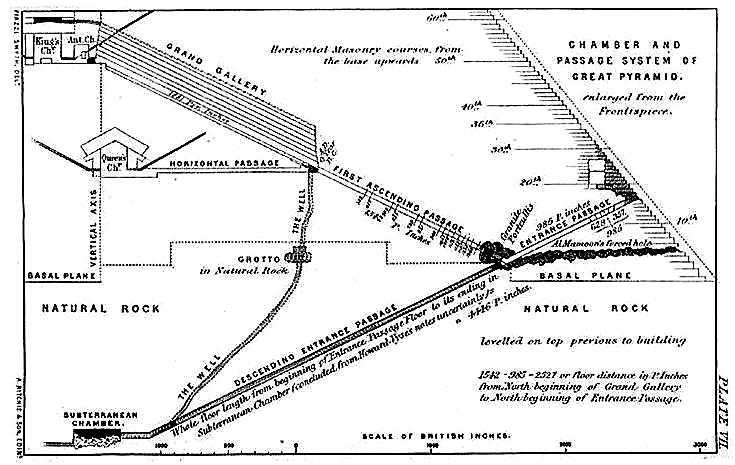There is little evidence that Russell and his father were actual registered Freemasons but there's is evidence of Russell's association with that particular secular organization
had some connecting influence that he absorbed, in which he expressively taught himself and published in his own literature.
As its known the Pyramid form has symbolic relevance toward Freemason theology, the very reason why you see it on the US dollar for example.
Russell like other speculative theorists of his era also got caught up in Pyramidlogy by noted British astronomer Charles Smyth and his book .
Our Inheritance in the Great Pyramid
.
Pyramidological researches
Smyth corresponded with pyramid theorist John Taylor and was heavily influenced by him. Taylor theorized in his 1859 book The Great Pyramid: Why Was It Built? & Who Built It? that the Great Pyramid was planned and the building supervised by the biblical Noah. Refused a grant by the Royal Society, Smyth went on an expedition to Egypt in order to accurately measure every surface, dimension, and aspect of the Great Pyramid. He brought along equipment to measure the dimensions of the stones, the precise angle of sections such as the descending passage, and a specially designed camera to photograph both the interior and exterior of the pyramid. He also used other instruments to make astronomical calculations and determine the pyramid's accurate latitude and longitude.
 This diagram from Smyth's Our Inheritance in the Great Pyramid (1877) shows some of his measurements and chronological determinations made from them
This diagram from Smyth's Our Inheritance in the Great Pyramid (1877) shows some of his measurements and chronological determinations made from them
Smyth subsequently published his book Our Inheritance in the Great Pyramid in 1864 (which he expanded over the years and is also titled The Great Pyramid: Its Secrets and Mysteries Revealed). Smyth claimed that the measurements he obtained from the Great Pyramid of Giza indicated a unit of length, the pyramid inch, equivalent to 1.001 British inches, that could have been the standard of measurement by the pyramid's architects. From this he extrapolated a number of other measurements, including the pyramid pint, the sacred cubit, and the pyramid scale of temperature.
Smyth claimed that the pyramid inch was a God-given measure handed down through the centuries from the time of Shem (Noah's Son), and that the architects of the pyramid could only have been directed by the hand of God. To support this Smyth said that, in measuring the pyramid, he found the number of inches in the perimeter of the base equalled one thousand times the number of days in a year, and found a numeric relationship between the height of the pyramid in inches to the distance from Earth to the Sun, measured in statute miles. He also advanced the theory that the Great Pyramid was a repository of prophecies which could be revealed by detailed measurements of the structure. Working upon theories by Taylor, he conjectured that the Hyksos were the Hebrew people, and that they built the Great Pyramid under the leadership of Melchizedek. Because the pyramid inch was a divine unit of measurement, Smyth, a committed proponent of British Israelism, used his conclusions as an argument against the introduction of the metric system in Britain. For much of his life he was a vocal opponent of the metric system, which he considered a product of the minds of atheistic French radicals, a position advocated in many of his works.
Smyth, despite his bad reputation in Egyptological circles today, performed much valuable work at Giza. He made the most accurate measurements of the Great Pyramid that any explorer had made up to that time, and he photographed the interior passages, using a magnesium light, for the first time. Smyth's work resulted in many drawings and calculations, which were soon incorporated into his books Our Inheritance in the Great Pyramid, the three-volume Life and Work at the Great Pyramid (1867), and On the Antiquity of Intellectual Man (1868). For his works he was awarded a gold medal by the Royal Society of Edinburgh, but in 1874, the Royal Society rejected his paper on the design of Khufu's pyramid, as they had Taylor's. The rejection of his ideas helped contribute to his resignation from his post as Royal Astronomer in 1888.
Influence of Smyth's pyramid theories
Smyth's theories on pyramid prophecy were then integrated into the works and prophecies of Charles Taze Russell(such as his Studies in the Scriptures), who founded the Bible Student movement (most visible today in the Jehovah's Witnesses, though Russell's successor, Joseph F. Rutherford, denounced pyramidology as unscriptural). Smyth's proposed dates for the Second Coming, first 1882 then many dates between 1892 and 1911, were failed predictions.
.
So one can see that Russell gravitated toward many different sources of information which he thought carried appealing relevance or he could further propagate to the public.
To this day there are ancient Egyptian images inside the Pittsburgh Freemason Hall, which makes one wonder if he had some influence in placing the
images there or were they there before his time and they influenced him ???
.
Interesting enough C. Smyth also had a stone monument of a Pyramid place at his grave site just like Russell.

.

